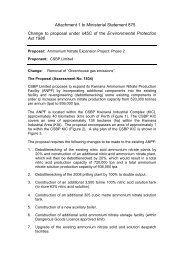Inland Waters of the Pilbara, Western Australia - Environmental ...
Inland Waters of the Pilbara, Western Australia - Environmental ...
Inland Waters of the Pilbara, Western Australia - Environmental ...
You also want an ePaper? Increase the reach of your titles
YUMPU automatically turns print PDFs into web optimized ePapers that Google loves.
3.5.2 VEGETATION PATIERNS<br />
The physiology and physiognomy <strong>of</strong> a species are <strong>of</strong> course related to <strong>the</strong> habitat in which it<br />
occurs. The presence or absence <strong>of</strong> species which are known to be confined to specific<br />
habitats allow <strong>the</strong>m to be used as indicators <strong>of</strong> certain environmental variables. and can be<br />
useful in differentiating between types <strong>of</strong> inland waters.<br />
Analysis <strong>of</strong> <strong>the</strong> flora, and a knowledge <strong>of</strong> <strong>the</strong> physiology <strong>of</strong> certain plant species, allowed<br />
recognition <strong>of</strong> patterns related to <strong>the</strong> water table, persistence and periodicity <strong>of</strong> inundation<br />
characteristic <strong>of</strong> particular inland water types (Table 5).<br />
3.5.2.1 Melaleucas<br />
Melaleuca leucadendran (<strong>the</strong> cajeput) has a shallow platform root system occupying a large<br />
area, well developed aerenchyma and <strong>the</strong> ability to cope with waterlogged conditions for<br />
extended periods <strong>of</strong> time. It is apparently dependent on water table levels between 1 and 2 m<br />
from <strong>the</strong> surface (Dames and Moore, 1975). According to bush-lore, large, thick-trunked<br />
cajeputs are indicative <strong>of</strong> permanent water. Consistent with <strong>the</strong>ir ecophysiology, M<br />
leucadendran, M glomerata and M linophylla were restricted to wetland types 1, 2, 3, 4 and<br />
one site under tidal influence (Table 5).<br />
3.5.2.2 Eucalypts<br />
Eucalyptus camaldulensis (<strong>the</strong> river gum) and E coolabah (<strong>the</strong> coolabah) withstand drought<br />
conditions for considerable lengths <strong>of</strong> time, but apparently obtain an advantage by being<br />
near water during <strong>the</strong>ir early growth and establishment. These eucalyptus appear fairly<br />
susceptible to long periods <strong>of</strong> static flooding. Moving flood waters, and water tables below 2<br />
m, appear to favour <strong>the</strong> growth and survival <strong>of</strong> <strong>the</strong>se eucalypts. They were found in <strong>the</strong> same<br />
locations as <strong>the</strong> melaleucas. with <strong>the</strong> addition <strong>of</strong> <strong>the</strong> semi-permanent claypans and<br />
adjoining pools: wetland types 5 and 7. River gums and coolabahs usually occupy distinct<br />
but overlapping zones in relation to <strong>the</strong> water body, with coolabahs predominantly in <strong>the</strong><br />
drier areas.<br />
3.5.2.3 Sesbanias<br />
The development <strong>of</strong> cork-like aerenchymous tissue in <strong>the</strong> root, stem and nodules <strong>of</strong> <strong>the</strong><br />
legumes Sesbania formosa and S cannabina allow <strong>the</strong> establishment <strong>of</strong> seedlings along<br />
high water zones and enable <strong>the</strong> mature plants to survive waterlogging in a similar manner<br />
to that described for Viminariajuncea, a native wetland legume found in <strong>the</strong> southwest <strong>of</strong><br />
<strong>the</strong> state (Walker, Pate and Kuo, 1983). Due to <strong>the</strong>ir fast growth and adaptability, <strong>the</strong>se<br />
legumes have <strong>the</strong> potential to colonise disturbed areas. S cannabina is <strong>of</strong>ten found on steep<br />
banks cut by river or stream flow (eg Mulye Pool, site 39) and also road verges (eg Shay Gap,<br />
site 40). S formosa may reach 7 or 8 m in height, and large plants are only found near<br />
permanent water (eg Eera Baranna. site 54).<br />
3.5.2.4 Ag_uatic Macrophytes<br />
The emergent and submerged aquatic macrophytes are also useful indicator species.<br />
Vallisneria sp., Myriophyllum sp., and Potamogeton sp. are submerged/semi-emergent.<br />
rooted angiosperms and can be seen to occupy only <strong>the</strong> spring-fed and river pool systems<br />
(see Table 5). The emergents Schoenoplectus litoralis (=Scirpus litoralis) and Typha<br />
domingensis show similar distributions, while Cyperus species are generally more<br />
opportunistic and may be found away from permanent or semi-permanent water.<br />
3.5.2.5 Pteridophytes and Chenopods<br />
Marsilea sp (nardoo}, an aquatic fern with floating leaves, capable <strong>of</strong> withstanding seasonal<br />
desiccation by resistant sporocarp formation, is a useful indicator <strong>of</strong> claypan conditions<br />
(see Table 6). Members <strong>of</strong> <strong>the</strong> halophylic Chenopodiaceae indicate salt affected areas, <strong>of</strong>ten<br />
difficult to distinguish from physical properties alone.<br />
29


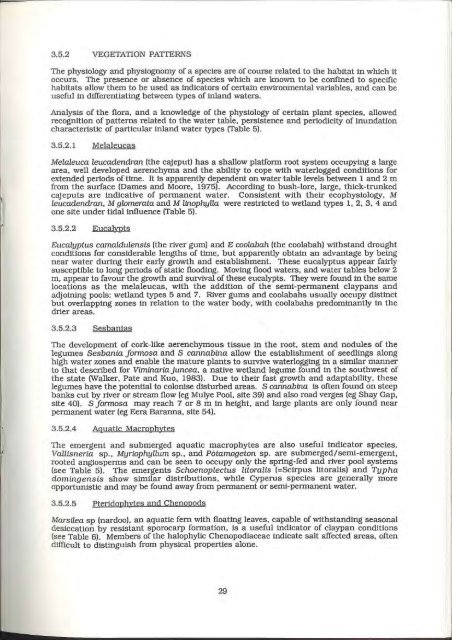
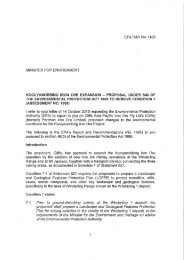
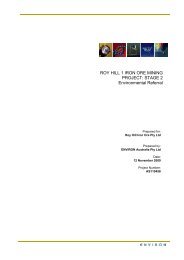

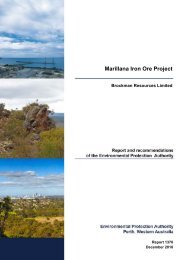
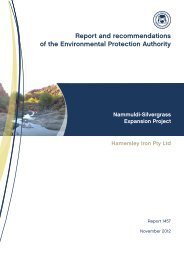
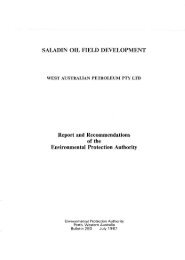
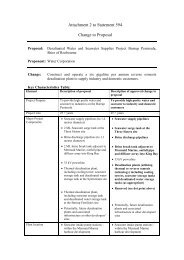

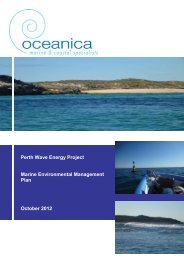
![[Project Title] - Environmental Protection Authority](https://img.yumpu.com/35475857/1/184x260/project-title-environmental-protection-authority.jpg?quality=85)

![[Project Title] - Environmental Protection Authority](https://img.yumpu.com/33147681/1/184x260/project-title-environmental-protection-authority.jpg?quality=85)
